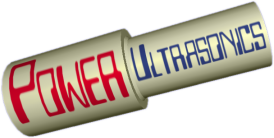Component materials
The materials for ultrasonically welded components are possibly the most important limitation - the process works best when both components are made from similar amorphous polymers. If only one of your components is suitable for welding (or they are incompatible) you should consider related ultrasonic joining techniques. If neither material is suitable for welding (eg. you are joining thermoset plastics) then you need to look for another joining method.
Dimensions
The size of a continuous ultrasonic weld depends on the horn (sonotrode) that makes it. But sonotrodes are limited in size by physical constraints based on the wavelength of the ultrasound used. Some typical "rules of thumb" for axial-mode sonotrodes (as used in plastic welding) are:
- sonotrode length is half a wavelength
- maximum diameter (or other lateral dimension) is one third of a wavelength, to avoid interference from other modes of vibration
But what is the wavelength? This depends on the operating frequency and sound velocity of the sonotrode material. In most cases (using a minimum frequency of 20kHz and common materials such as aluminium, titanium or stainless steel) the maximum wavelength is around 250mm (10 inches). So according to the rules above the lateral dimension of a sonotrode cannot ever be larger than about 80mm (just over 3 inches). For more on these calculations please see the sonotrode calculator.
Of course, these rules can be broken, or at least avoided! Lower frequencies, down to 15kHz or less, permit a larger sonotrode size but with significantly increased audible noise. Larger sonotrodes are often constructed using a series of slots, dividing them up into sections each of which individually obeys the rules. Or alternative modes of vibration (eg. radial) may be used which completely eliminate these limitations. In most cases though larger sections will have further, more complicated rules of their own - finite element analysis and a significant amount of prototyping work will be required to arrive at a successful sonotrode design.
To avoid the need for complex sonotrodes, or when very large components make a full-size sonotrode impossible, there are other approaches such as spot welding and scanning (moving the component under the horn), and rotating horns are sometimes used to create continuous linear welds.
Power
The power required for an ultrasonic welding process depends mainly on the size of the weld, the materials being welded and the efficiency of transmitting power through to the weld. Most ultrasonic systems use control systems to adjust power input automatically as the process demands it, but obviously within the capability of the generator and transducer. With modern electronics used in ultrasonic generators it is the transducer that dictates the maximum power the system can handle, because of the same constraints on physical size discussed above for sonotrodes. Modern ultrasonic transducers can often handle 3kW, and some claim as much as 6kW, which should push out the boundaries of ultrasonic welding viability.
Using multiple transducers might be thought to be a solution to this issue but in practice it's difficult to achieve in axial-mode systems, as used for plastic welding, unless the transducers can be applied to completely separate ultrasonic sytems. Thus multiple ultrasonic systems can make discrete welds in several locations on the components.
To some extent it is possible to compensate for limited power by increasing the weld time, but this is at best non-ideal and in some cases may not work at all. The main problem is that more time permits greater heat transfer out of the weld zone.
